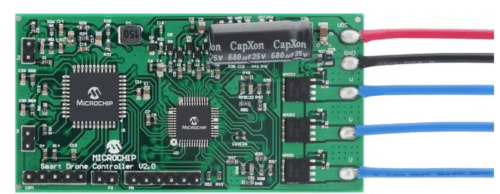Dive into technology with the dsPIC33EP Digital Signal Controller and Sinusoidal Field-Oriented Control, and learn how these innovations are revolutionizing drone propeller design and performance while ensuring a quieter and more efficient flight experience.

Drone propellers, while often overlooked, are paramount components that underpin the functionality and versatility of unmanned aerial vehicles (UAVs). These essential rotating blades are more than just a means to keep drones aloft; they are the driving force behind a wide array of applications that range from aerial photography and surveillance to delivery services and search-and-rescue missions. The choice of the right drone propeller can significantly impact flight performance, battery life, payload capacity, and noise emissions. Therefore, understanding their importance and tailoring their selection to specific applications is pivotal in harnessing the full potential of drones across various industries, from entertainment and agriculture to emergency response and beyond.
The dsPIC33EP Digital Signal Controller (DSC) is the foundation for this advanced drone propeller reference design. It incorporates sensorless sinusoidal Field-Oriented Control (FOC) for three-phase BLDC motors tailored specifically for drone applications. This design is engineered to elevate a drone’s performance by enhancing its dynamic response during acceleration, ensuring precise torque control, and significantly reducing operational noise for a quieter flying experience. Key features of this reference design encompass a three-phase motor control inverter, phase current feedback through two shunts for superior performance, phase voltage feedback facilitating sensorless trapezoidal control or flying start, DC bus voltage feedback for added over-voltage protection, and an In-Circuit Serial Programming (ICSP) header compatible with our programmer/debugger. Additionally, it incorporates a CAN communication header for enhanced connectivity and control capabilities.
Sinusoidal Field-Oriented Control (FOC) offers several advantages as an alternative to trapezoidal control. It enhances dynamic response during acceleration, ensuring smoother and more precise motor control. This method also enables stable torque control while minimizing electromagnetic interference (EMI) and noise emissions, resulting in a quieter and more efficient operation. Additionally, Sinusoidal FOC improves motor stalls’ handling and protection mechanisms, enhancing overall reliability. All these benefits are packaged compact, making it an attractive choice for various applications.This system’s input DC voltage range is between 10V and 14V, with an absolute maximum input limit of 20V. Through the VDC and GND connectors, the maximum allowable input current is 10A. Furthermore, under typical operating conditions at 25°C, each phase can continuously output a current of 44A, with the capability to momentarily peak at this level when necessary.
Microchip has thoroughly tested this reference design, which includes a Design Guide, Bill of Materials (BOM), schematics, Printed Circuit Board (PCB) layout, and more. Please visit the company’s website for further information on this reference design. To explore this design in greater detail, click here.





